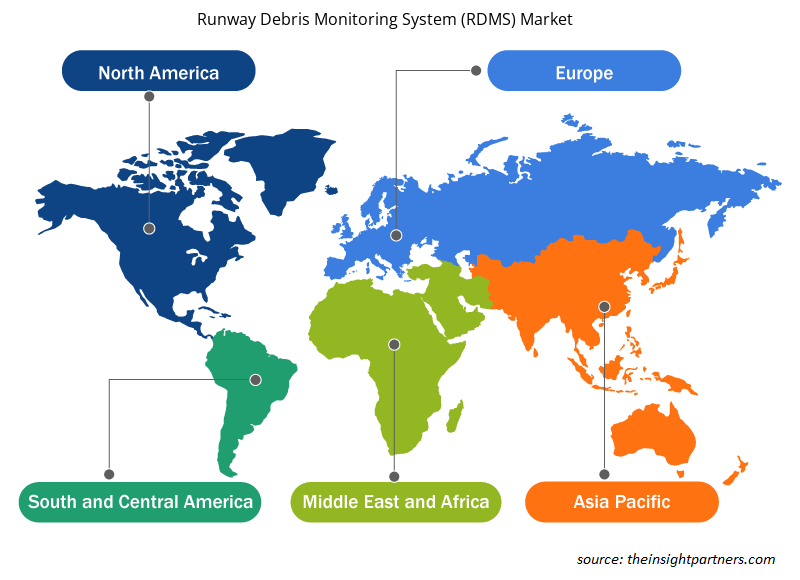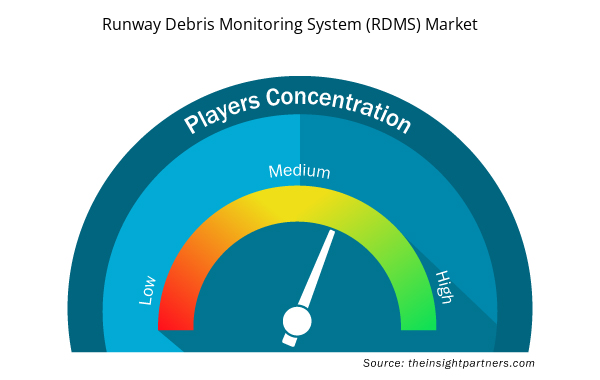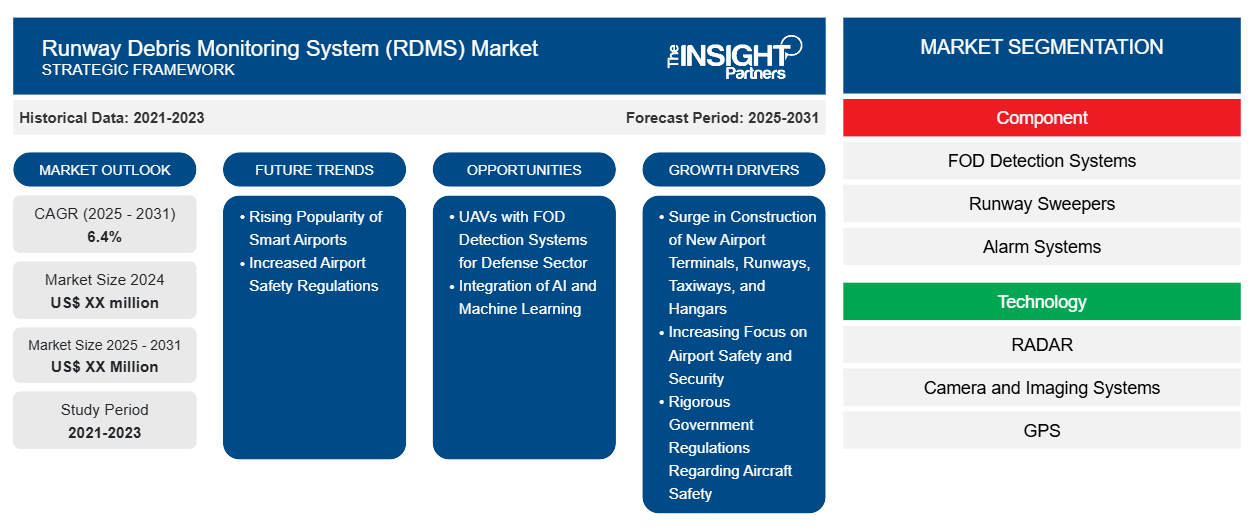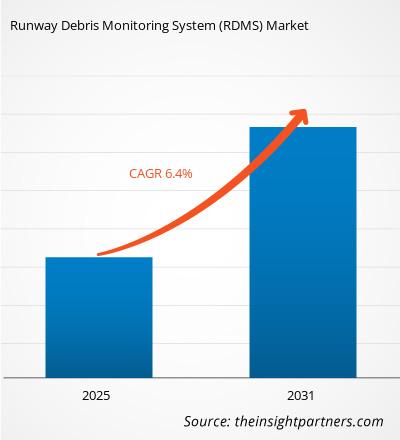Si prevede che il mercato dei sistemi di monitoraggio dei detriti di pista (RDMS) registrerà un CAGR del 6,4% dal 2023 al 2031, con una dimensione di mercato in espansione da XX milioni di dollari nel 2023 a XX milioni di dollari entro il 2031.
Il report è suddiviso in base a Componente (FOD Detection Systems, Runway Sweepers, Alarm Systems, Others); Tecnologia (RADAR, Camera and Imaging Systems, GPS, Laser, Others); Applicazione (Detection, Identification, Risk Assessment, Removal, Analysis, Others); Piattaforma (Fixed, Mobile). L'analisi globale è ulteriormente suddivisa a livello regionale e nei principali paesi. Il report offre il valore in USD per l'analisi e i segmenti di cui sopra.
Scopo del rapporto
Il report Runway Debris Monitoring System (RDMS) Market di The Insight Partners mira a descrivere il panorama attuale e la crescita futura, i principali fattori trainanti, le sfide e le opportunità. Ciò fornirà spunti a vari stakeholder aziendali, come:
- Fornitori/produttori di tecnologia: per comprendere le dinamiche di mercato in evoluzione e conoscere le potenziali opportunità di crescita, consentendo loro di prendere decisioni strategiche informate.
- Investitori: condurre un'analisi completa delle tendenze in merito al tasso di crescita del mercato, alle proiezioni finanziarie del mercato e alle opportunità esistenti lungo la catena del valore.
- Enti di regolamentazione: regolamentano le politiche e le attività di controllo sul mercato allo scopo di ridurre al minimo gli abusi, preservare la fiducia degli investitori e sostenere l'integrità e la stabilità del mercato.
Segmentazione del mercato del sistema di monitoraggio dei detriti di pista (RDMS)
Componente
- Sistemi di rilevamento FOD
- Spazzatrici di pista
- Sistemi di allarme
- Altri
Tecnologia
- RADAR
- Sistemi di telecamere e di imaging
- GPS
- Laser
- Altri.
Applicazione
- Rilevamento
- Identificazione
- Valutazione del rischio
- Rimozione
- Analisi
- Altri
Piattaforma
- Fisso
- Mobile
Piattaforma
- Fisso
- Mobile
Personalizza questo report in base alle tue esigenze
Riceverai la personalizzazione gratuita di qualsiasi report, comprese parti di questo report, o analisi a livello nazionale, pacchetto dati Excel, oltre a usufruire di grandi offerte e sconti per start-up e università
- Scopri le principali tendenze di mercato in questo rapporto.Questo campione GRATUITO includerà analisi di dati che spaziano dalle tendenze di mercato alle stime e alle previsioni.
Fattori trainanti della crescita del mercato del sistema di monitoraggio dei detriti in pista (RDMS)
- Aumento della costruzione di nuovi terminal aeroportuali, piste, vie di rullaggio e hangar: il crescente numero di flotte di aeromobili commerciali globali è uno dei principali fattori che generano la domanda di nuovi voli, terminal, piste e hangar in diversi aeroporti per soddisfare il crescente traffico passeggeri in tutto il mondo. Ciò alimenta gli investimenti delle autorità aeroportuali per aggiornare i rispettivi locali aeroportuali per soddisfare un'enorme flotta di aeromobili, il che migliora anche l'efficienza operativa complessiva dell'aeroporto. A maggio 2021, l'aeroporto internazionale del Kansai (KIX) ha avviato un progetto di espansione incentrato sulla gestione di circa 40 milioni di passeggeri internazionali all'anno. Si prevede che il progetto sarà completato entro il 2025 per l'Expo 2025 di Osaka nel Kansai. Pertanto, la costruzione di nuovi terminal aeroportuali, piste, vie di rullaggio e hangar contribuisce alla crescita del mercato dei sistemi di monitoraggio dei detriti delle piste.
- Maggiore attenzione alla sicurezza aeroportuale: con le crescenti preoccupazioni sui rischi per la sicurezza posti dai detriti di oggetti estranei (FOD) sulle piste, gli aeroporti e le autorità aeronautiche stanno investendo in sistemi avanzati di monitoraggio dei detriti. La necessità di prevenire incidenti in pista, migliorare l'efficienza operativa e rispettare le più severe normative di sicurezza sta guidando la domanda di questi sistemi.
Rigorose normative governative in materia di sicurezza degli aeromobili: la presenza di FOD (detriti di oggetti estranei) è una preoccupazione persistente negli aeroporti. La Federal Aviation Administration (FAA) ha presentato linee guida per la produzione e l'approvvigionamento di sistemi di rilevamento dei detriti di oggetti estranei (FOD) sulle piste degli aeroporti. Tutti i clienti e i produttori devono rispettare le norme stabilite dalla FAA per l'ottenimento e la produzione di sistemi di rilevamento dei FOD. Le compagnie aeree, gli aeroporti e la comunità dell'aviazione generale hanno adottato misure essenziali per ridurre al minimo i FOD impegnandosi in efficaci programmi di gestione dei FOD, come da AC 150/5210-24. Le circolari del programma FAA Foreign Object Debris come AC 150/5210-24, Airport Foreign Object Debris (FOD) Management, descrivono FOD come qualsiasi oggetto, vivo o meno, situato in una posizione non idonea nell'ambiente aeroportuale che può danneggiare il personale dell'aeroporto o della compagnia aerea e danneggiare gli aeromobili. Pertanto, rigorose normative governative in materia di sicurezza degli aeromobili guidano il mercato dei sistemi di monitoraggio dei detriti in pista.
Tendenze future del mercato del sistema di monitoraggio dei detriti di pista (RDMS)
- Crescente popolarità degli aeroporti intelligenti: la crescente inclinazione delle autorità governative verso gli aeroporti intelligenti aumenta la domanda di implementazione di sistemi intelligenti nei locali aeroportuali. I governi di paesi sviluppati come Stati Uniti, Regno Unito e Cina stanno capitalizzando sulle tecnologie degli aeroporti intelligenti, tra cui sistemi di comunicazione e di rete, sensori intelligenti, telecamere, tag RFID e dispositivi indossabili, a causa della crescente preferenza per le informazioni in tempo reale e della crescente domanda di tecnologie di connettività avanzate nelle operazioni aeroportuali. Pertanto, si prevede che la crescente attenzione verso gli aeroporti intelligenti creerà opportunità redditizie per la crescita del mercato dei sistemi di monitoraggio dei detriti delle piste durante il periodo di previsione.
- Norme di sicurezza aeroportuale più severe: man mano che le autorità aeronautiche globali inaspriscono gli standard di sicurezza, cresce l'opportunità di sistemi avanzati di monitoraggio dei detriti che soddisfano i requisiti di conformità. Gli aeroporti investiranno in nuove tecnologie per garantire la sicurezza delle piste ed evitare costosi ritardi o incidenti dovuti a detriti di oggetti estranei (FOD).
Opportunità di mercato del sistema di monitoraggio dei detriti di pista (RDMS)
- UAV con sistemi di rilevamento FOD per il settore della difesa: l'implementazione di veicoli aerei senza pilota (UAV) da parte del personale militare per applicazioni quali sorveglianza, operazioni di combattimento, trasporto e consegna e gestione dei danni da battaglia è in crescita. Ad esempio, a maggio 2024, SkyLark Labs ha collaborato con Mercedes-Benz India Pvt. Ltd., utilizzando un sistema Mobile-Foreign Object Debris basato sull'intelligenza artificiale (AI). Il sistema di rilevamento FOD è stato sviluppato principalmente per la Marina indiana nell'ambito dell'organizzazione per l'innovazione della difesa iDEX. La soluzione avanzata attribuisce potenziali di autoapprendimento avanzati, consentendole di aggiornare costantemente le sue prestazioni e modificarle in base al mutevole panorama FOD. Pertanto, si prevede che l'integrazione di UAV con sistemi di rilevamento FOD per il settore della difesa stabilirà nuove tendenze nel mercato dei sistemi di monitoraggio dei detriti delle piste nei prossimi anni.
- Integrazione di AI e Machine Learning: i moderni sistemi di monitoraggio dei detriti in pista stanno sempre più incorporando algoritmi di AI e machine learning per migliorare il rilevamento e l'analisi in tempo reale dei detriti. Queste tecnologie aiutano a identificare rapidamente potenziali minacce, riducendo i tempi di risposta e migliorando i protocolli di sicurezza aeroportuale.
Approfondimenti regionali sul mercato del sistema di monitoraggio dei detriti in pista (RDMS)
Le tendenze regionali e i fattori che influenzano il mercato del Runway Debris Monitoring System (RDMS) durante il periodo di previsione sono stati ampiamente spiegati dagli analisti di Insight Partners. Questa sezione discute anche i segmenti di mercato del Runway Debris Monitoring System (RDMS) e la geografia in Nord America, Europa, Asia Pacifico, Medio Oriente e Africa e Sud e Centro America.

- Ottieni i dati specifici regionali per il mercato del sistema di monitoraggio dei detriti di pista (RDMS)
Ambito del rapporto di mercato sul sistema di monitoraggio dei detriti della pista (RDMS)
| Attributo del report | Dettagli |
|---|---|
| Dimensioni del mercato nel 2023 | XX milioni di dollari USA |
| Dimensioni del mercato entro il 2031 | XX milioni di dollari USA |
| CAGR globale (2023-2031) | 6,4% |
| Dati storici | 2021-2022 |
| Periodo di previsione | 2024-2031 |
| Segmenti coperti | Per componente
|
| Regioni e Paesi coperti | America del Nord
|
| Leader di mercato e profili aziendali chiave |
|
Sistema di monitoraggio dei detriti di pista (RDMS) Attori del mercato Densità: comprendere il suo impatto sulle dinamiche aziendali
Il mercato del Runway Debris Monitoring System (RDMS) sta crescendo rapidamente, spinto dalla crescente domanda degli utenti finali dovuta a fattori quali l'evoluzione delle preferenze dei consumatori, i progressi tecnologici e una maggiore consapevolezza dei vantaggi del prodotto. Con l'aumento della domanda, le aziende stanno ampliando le loro offerte, innovando per soddisfare le esigenze dei consumatori e capitalizzando sulle tendenze emergenti, il che alimenta ulteriormente la crescita del mercato.
La densità degli operatori di mercato si riferisce alla distribuzione di aziende o società che operano in un particolare mercato o settore. Indica quanti concorrenti (operatori di mercato) sono presenti in un dato spazio di mercato in relazione alle sue dimensioni o al valore di mercato totale.
Le principali aziende che operano nel mercato dei sistemi di monitoraggio dei detriti di pista (RDMS) sono:
- Radar di Navtech
- QinetiQ
- Gruppo Talete
- Azienda
- Rheinmetall AG
Disclaimer : le aziende elencate sopra non sono classificate secondo un ordine particolare.

- Ottieni la panoramica dei principali attori del mercato del sistema di monitoraggio dei detriti di pista (RDMS)
Punti chiave di vendita
- Copertura completa: il rapporto copre in modo completo l'analisi di prodotti, servizi, tipologie e utenti finali del mercato dei sistemi di monitoraggio dei detriti di pista (RDMS), fornendo una panoramica olistica.
- Analisi degli esperti: il rapporto è compilato sulla base della conoscenza approfondita di esperti e analisti del settore.
- Informazioni aggiornate: il rapporto garantisce la pertinenza aziendale grazie alla copertura di informazioni recenti e tendenze nei dati.
- Opzioni di personalizzazione: questo report può essere personalizzato per soddisfare le esigenze specifiche del cliente e adattarsi in modo appropriato alle strategie aziendali.
Il rapporto di ricerca sul mercato Runway Debris Monitoring System (RDMS) può quindi aiutare a guidare il percorso di decodifica e comprensione dello scenario del settore e delle prospettive di crescita. Sebbene possano esserci alcune preoccupazioni valide, i vantaggi complessivi di questo rapporto tendono a superare gli svantaggi.
- Analisi storica (2 anni), anno base, previsione (7 anni) con CAGR
- Analisi PEST e SWOT
- Valore/volume delle dimensioni del mercato - Globale, regionale, nazionale
- Industria e panorama competitivo
- Set di dati Excel



Report Coverage
Revenue forecast, Company Analysis, Industry landscape, Growth factors, and Trends

Segment Covered
This text is related
to segments covered.

Regional Scope
North America, Europe, Asia Pacific, Middle East & Africa, South & Central America

Country Scope
This text is related
to country scope.
Domande frequenti
The report can be delivered in PDF/PPT format; we can also share excel dataset based on the request.
Some of the customization options available based on the request are an additional 3-5 company profiles and country-specific analysis of 3-5 countries of your choice. Customizations are to be requested/discussed before making final order confirmation, as our team would review the same and check the feasibility.
Rising Popularity of Smart Airports is the key future trend of the Runway Debris Monitoring System (RDMS) Market
The leading players operating in the Runway Debris Monitoring System (RDMS) Market include ArgosAI Teknoloji A.?.; Moog Inc.; Navtech Radar; Pavemetrics; Plextek Services Limited; Rheinmetall AG; QinetiQ Group Plc; Thales SA; Xsight Systems Ltd.; Trex Aviation Systems; Varec, Inc.; Smiths Detection Group Ltd. (Smiths Group plc); Infologic Pte Ltd.; Skylarklabs, Inc.; Hitachi Ltd
The Runway Debris Monitoring System (RDMS) Market is estimated to witness a CAGR of 6.4% from 2023 to 2031
The major factors driving the Runway Debris Monitoring System (RDMS) Market are: Surge in Construction of New Airport Terminals, Runways, Taxiways, and Hangars and Rigorous Government Regulations Regarding Aircraft Safety
Trends and growth analysis reports related to Aerospace and Defense : READ MORE..
1. Navtech Radar
2. QinetiQ
3. Thales Group
4. Moog Inc.
5. Rheinmetall AG
6. Varec, Inc. (Leidos)
7. Pavemetrics
8. Xsight Systems
9. Rolls-Royce plc
10. WAVE TECH Co.,Ltd.
The Insight Partners performs research in 4 major stages: Data Collection & Secondary Research, Primary Research, Data Analysis and Data Triangulation & Final Review.
- Data Collection and Secondary Research:
As a market research and consulting firm operating from a decade, we have published and advised several client across the globe. First step for any study will start with an assessment of currently available data and insights from existing reports. Further, historical and current market information is collected from Investor Presentations, Annual Reports, SEC Filings, etc., and other information related to company’s performance and market positioning are gathered from Paid Databases (Factiva, Hoovers, and Reuters) and various other publications available in public domain.
Several associations trade associates, technical forums, institutes, societies and organization are accessed to gain technical as well as market related insights through their publications such as research papers, blogs and press releases related to the studies are referred to get cues about the market. Further, white papers, journals, magazines, and other news articles published in last 3 years are scrutinized and analyzed to understand the current market trends.
- Primary Research:
The primarily interview analysis comprise of data obtained from industry participants interview and answers to survey questions gathered by in-house primary team.
For primary research, interviews are conducted with industry experts/CEOs/Marketing Managers/VPs/Subject Matter Experts from both demand and supply side to get a 360-degree view of the market. The primary team conducts several interviews based on the complexity of the markets to understand the various market trends and dynamics which makes research more credible and precise.
A typical research interview fulfils the following functions:
- Provides first-hand information on the market size, market trends, growth trends, competitive landscape, and outlook
- Validates and strengthens in-house secondary research findings
- Develops the analysis team’s expertise and market understanding
Primary research involves email interactions and telephone interviews for each market, category, segment, and sub-segment across geographies. The participants who typically take part in such a process include, but are not limited to:
- Industry participants: VPs, business development managers, market intelligence managers and national sales managers
- Outside experts: Valuation experts, research analysts and key opinion leaders specializing in the electronics and semiconductor industry.
Below is the breakup of our primary respondents by company, designation, and region:

Once we receive the confirmation from primary research sources or primary respondents, we finalize the base year market estimation and forecast the data as per the macroeconomic and microeconomic factors assessed during data collection.
- Data Analysis:
Once data is validated through both secondary as well as primary respondents, we finalize the market estimations by hypothesis formulation and factor analysis at regional and country level.
- Macro-Economic Factor Analysis:
We analyse macroeconomic indicators such the gross domestic product (GDP), increase in the demand for goods and services across industries, technological advancement, regional economic growth, governmental policies, the influence of COVID-19, PEST analysis, and other aspects. This analysis aids in setting benchmarks for various nations/regions and approximating market splits. Additionally, the general trend of the aforementioned components aid in determining the market's development possibilities.
- Country Level Data:
Various factors that are especially aligned to the country are taken into account to determine the market size for a certain area and country, including the presence of vendors, such as headquarters and offices, the country's GDP, demand patterns, and industry growth. To comprehend the market dynamics for the nation, a number of growth variables, inhibitors, application areas, and current market trends are researched. The aforementioned elements aid in determining the country's overall market's growth potential.
- Company Profile:
The “Table of Contents” is formulated by listing and analyzing more than 25 - 30 companies operating in the market ecosystem across geographies. However, we profile only 10 companies as a standard practice in our syndicate reports. These 10 companies comprise leading, emerging, and regional players. Nonetheless, our analysis is not restricted to the 10 listed companies, we also analyze other companies present in the market to develop a holistic view and understand the prevailing trends. The “Company Profiles” section in the report covers key facts, business description, products & services, financial information, SWOT analysis, and key developments. The financial information presented is extracted from the annual reports and official documents of the publicly listed companies. Upon collecting the information for the sections of respective companies, we verify them via various primary sources and then compile the data in respective company profiles. The company level information helps us in deriving the base number as well as in forecasting the market size.
- Developing Base Number:
Aggregation of sales statistics (2020-2022) and macro-economic factor, and other secondary and primary research insights are utilized to arrive at base number and related market shares for 2022. The data gaps are identified in this step and relevant market data is analyzed, collected from paid primary interviews or databases. On finalizing the base year market size, forecasts are developed on the basis of macro-economic, industry and market growth factors and company level analysis.
- Data Triangulation and Final Review:
The market findings and base year market size calculations are validated from supply as well as demand side. Demand side validations are based on macro-economic factor analysis and benchmarks for respective regions and countries. In case of supply side validations, revenues of major companies are estimated (in case not available) based on industry benchmark, approximate number of employees, product portfolio, and primary interviews revenues are gathered. Further revenue from target product/service segment is assessed to avoid overshooting of market statistics. In case of heavy deviations between supply and demand side values, all thes steps are repeated to achieve synchronization.
We follow an iterative model, wherein we share our research findings with Subject Matter Experts (SME’s) and Key Opinion Leaders (KOLs) until consensus view of the market is not formulated – this model negates any drastic deviation in the opinions of experts. Only validated and universally acceptable research findings are quoted in our reports.
We have important check points that we use to validate our research findings – which we call – data triangulation, where we validate the information, we generate from secondary sources with primary interviews and then we re-validate with our internal data bases and Subject matter experts. This comprehensive model enables us to deliver high quality, reliable data in shortest possible time.


 Ottieni un campione gratuito per questo repot
Ottieni un campione gratuito per questo repot